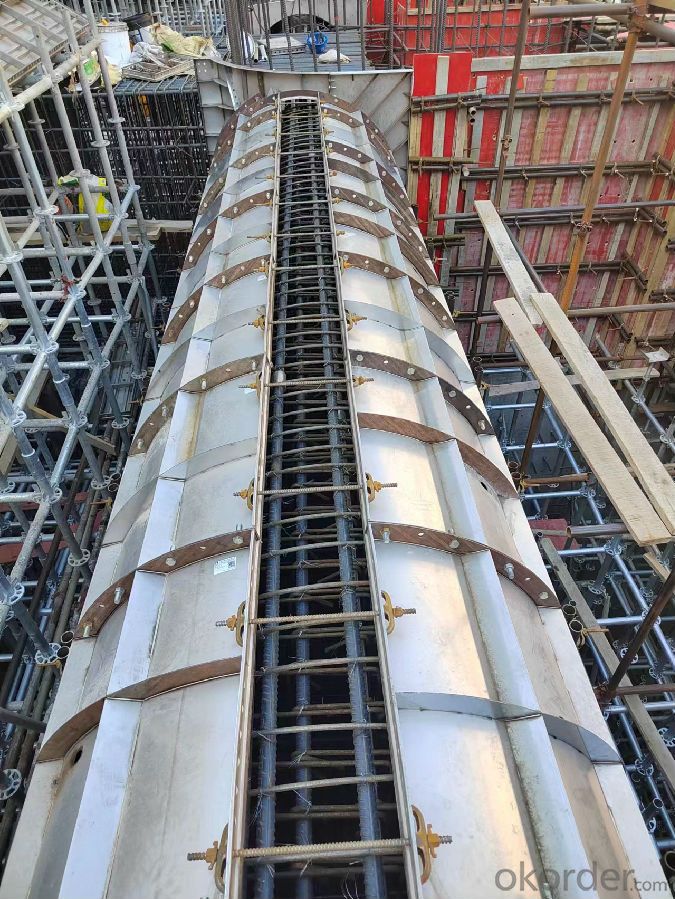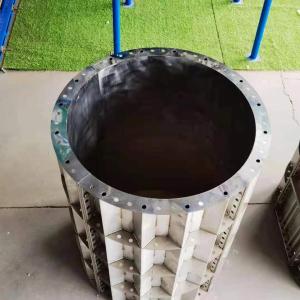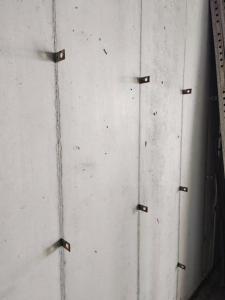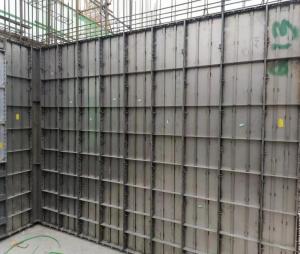Hot seller-steel formwork for concrete,concrete column formwork , Stainless Steel Formwork
- Loading Port:
- Shanghai
- Payment Terms:
- TT or LC
- Min Order Qty:
- 1 set
- Supply Capability:
- 1000000 set/month
OKorder Service Pledge
OKorder Financial Service
You Might Also Like
Stainless steel formwork
Replaceable size aluminum formwork :400X1200mm , 400X1500mm
PRODUCT CHARACTERISTICS
Stainless steel side profiles
80kn/M2 maximum pressure
3 different heights; 1.2m, 2.7m and 3.3m
suitable to be used on any site where circular walls need to be poured. Adjusting the radii is easy and simple, making Conflex a cost-effective system.
Advantages:
1 Stainless steel formwork, 100% follow the design of aluminum alloy formwork system, it is interchangeable, compatible and can be used together with aluminum formwork at the same time .
2It is made of high-strength stainless steel strip by rolling and laser welding. It has good corrosion resistance and high density,is not easy to rust and has no fire hazard.
3Long service life, many turnover times, high recycling value
The number of turnovers is large, especially the characteristics of no dust, no need to brush or less mold release agent, and the characteristics of low renovation costs will bring unlimited optimistic prospects to it.



- Q:How does steel formwork handle formwork stripping and reassembly?
- Due to its strength, durability, and versatility, steel formwork is extremely effective in handling the stripping and reassembly of formwork. When it comes to removing the formwork after the concrete has set, steel formwork systems are specifically designed to allow for easy and efficient removal. The steel panels can be easily detached from the structure, and the formwork components can be disassembled without causing any damage to the formwork system or the concrete structure. In addition, steel formwork offers fast and effortless reassembly capabilities. The panels can be easily repositioned and securely locked back into place, ensuring precise alignment for the next concrete pour. The interlocking mechanism of steel formwork guarantees a tight and secure connection, preventing any movement or displacement during the pouring and curing process. Furthermore, steel formwork is known for its reusability. Unlike traditional timber formwork, steel formwork can be used multiple times without compromising its structural integrity. This not only makes it cost-effective but also reduces the environmental impact associated with generating formwork waste. Another advantage of steel formwork is its adaptability to various project requirements. Steel panels can be easily modified or customized to accommodate complex shapes, angles, or curves, providing flexibility in different construction applications. This adaptability ensures that steel formwork can efficiently handle the stripping and reassembly process, regardless of the design complexities of the project. In conclusion, steel formwork is a highly dependable and efficient choice for handling formwork stripping and reassembly. Its strength, durability, reusability, and adaptability make it the preferred option in the construction industry, allowing for seamless and hassle-free formwork operations.
- Q:What are the different safety certifications and standards for steel formwork?
- There are several safety certifications and standards for steel formwork used in construction projects. Some of the most common ones include ISO 9001 certification, which ensures quality management systems are in place; OHSAS 18001 certification, which indicates compliance with occupational health and safety standards; and EN 12812 standard, which defines requirements for temporary works equipment such as formwork. Additionally, local building codes and regulations play a crucial role in ensuring the safety of steel formwork installations.
- Q:Is steel formwork more environmentally friendly than other types of formwork?
- There are several reasons why steel formwork is considered to be a more environmentally friendly option than other types of formwork. Firstly, steel is an incredibly durable material that can be reused multiple times, reducing the need for constant production of new formwork materials. This helps to conserve natural resources and minimize waste. Furthermore, steel formwork has a longer lifespan compared to materials like timber or plywood, which often degrade over time and need frequent replacement. This longevity reduces the overall consumption of formwork materials and the associated environmental impact. In addition, steel formwork can be easily recycled at the end of its life, further reducing waste and minimizing the carbon footprint. The recycling process for steel is highly efficient and requires much less energy compared to the production of new steel. This results in significant energy savings and reduced greenhouse gas emissions. Moreover, steel formwork is resistant to moisture and other elements, eliminating the need for chemical treatments to protect it from decay or damage. This reduces the release of harmful substances into the environment, making steel formwork a safer and more sustainable option. However, it is important to consider that the environmental impact of steel formwork can also be influenced by factors such as the manufacturing processes used, transportation distances, and the specific requirements of a project. Therefore, it is crucial to assess the entire life cycle of the formwork and make well-informed decisions based on the specific circumstances to ensure the most environmentally friendly choice.
- Q:Is steel formwork more expensive than other types of formwork?
- The cost of steel formwork depends on various factors such as the size and complexity of the project, availability of materials, labor costs, and market conditions. Generally speaking, steel formwork tends to be more expensive than other types of formwork such as wood or aluminum. Steel formwork offers several advantages over other types of formwork, such as high durability, reusability, and the ability to support heavy loads. However, these benefits come at a higher price. Steel formwork requires a higher initial investment due to the cost of materials and the need for skilled labor for fabrication and installation. On the other hand, wood or aluminum formwork may be less expensive initially, but they may not be as durable or have the same load-bearing capacity as steel formwork. They might require frequent repairs or replacements, which can add to the overall cost in the long run. Ultimately, the choice of formwork material depends on the specific requirements of the project, budget constraints, and the expected number of uses. While steel formwork may be more expensive upfront, it often provides a better return on investment due to its durability and reusability.
- Q:Can steel formwork be used for precast concrete columns?
- Yes, steel formwork can be used for precast concrete columns. Steel formwork offers several advantages for precast concrete column construction. Firstly, steel formwork is durable and can withstand the pressure exerted by the concrete during the casting process. This ensures that the formwork maintains its shape and integrity, resulting in accurately shaped columns. Additionally, steel formwork provides a smooth and consistent surface finish to the concrete columns. This is important for aesthetic purposes, as well as ensuring that the columns meet the required specifications. Steel formwork also allows for easy demolding and reusability, which can significantly reduce construction time and cost. Furthermore, steel formwork can be easily customized and adapted to different column designs and dimensions. This flexibility makes it suitable for a wide range of precast concrete column applications, including various shapes and sizes. However, it is important to consider certain factors when using steel formwork for precast concrete columns. The weight of the steel formwork should be adequately supported to prevent any deformation or collapse during the casting process. Additionally, proper precautions should be taken to prevent rusting or corrosion of the steel formwork, as this can affect the quality of the concrete. Overall, steel formwork is a viable option for precast concrete column construction, offering durability, flexibility, and ease of use.
- Q:Can steel formwork be used for both straight and curved concrete elements?
- Yes, steel formwork can be used for both straight and curved concrete elements. Steel formwork is highly versatile and can be easily adjusted and shaped to accommodate different design requirements. It offers excellent strength and durability, making it suitable for constructing both straight and curved concrete elements. The flexibility of steel formwork allows for the creation of complex and intricate shapes, making it ideal for projects that require curved elements such as architectural features, curved walls, or circular structures. Additionally, steel formwork provides a smooth and uniform surface finish, ensuring high-quality concrete results for both straight and curved elements.
- Q:What are the safety precautions when using steel formwork?
- When using steel formwork, there are several important safety precautions that should be followed to ensure the well-being of workers and the successful completion of the project. 1. Adequate training and awareness: All workers involved in using steel formwork should be properly trained on its safe handling and usage. They should be aware of the potential hazards and the correct procedures to follow. 2. Inspection and maintenance: Before using steel formwork, it is essential to inspect it thoroughly for any defects or damage. Any damaged or weakened parts should be repaired or replaced before use. Regular maintenance should be carried out to ensure the formwork remains in good condition. 3. Proper handling and storage: Steel formwork can be heavy and require multiple workers for handling. It is important to use appropriate lifting and handling equipment, such as cranes or forklifts, to avoid strain or injuries. When storing the formwork, it should be secured properly to prevent it from falling or causing accidents. 4. Fall protection: When working at heights with steel formwork, fall protection measures such as guardrails, safety nets, or personal fall arrest systems should be implemented. Workers should be provided with proper safety harnesses and trained on their usage. 5. Secure installation: Steel formwork should be securely installed to prevent collapse or movement during concrete pouring or other construction activities. It is crucial to follow the manufacturer's instructions and use appropriate bracing and support systems to ensure stability. 6. Adequate signage and barriers: Proper signage and barriers should be placed around the work area to warn others of potential hazards and restrict access to authorized personnel only. This helps in preventing accidents and keeping unauthorized individuals away from the construction site. 7. Personal protective equipment (PPE): All workers involved in using steel formwork should wear appropriate PPE, including hard hats, safety boots, gloves, and eye protection. This protects them from potential injuries caused by falling objects, sharp edges, or other hazards. 8. Regular communication and coordination: Effective communication and coordination among workers using steel formwork are crucial to maintain a safe working environment. Clear instructions, regular safety meetings, and the availability of emergency procedures ensure everyone is aware of their roles and responsibilities. By following these safety precautions, the risks associated with using steel formwork can be minimized, and a safe working environment can be maintained for all workers involved in the construction project.
- Q:What are the safety precautions when working with steel formwork?
- When working with steel formwork, it is important to follow certain safety precautions to ensure the well-being of the workers. These precautions include: 1. Proper training: All workers should receive comprehensive training on the correct usage of steel formwork. This includes understanding the assembly, disassembly, and handling of the formwork system. Workers should also be trained on how to identify any potential hazards or risks associated with the steel formwork. 2. Personal Protective Equipment (PPE): Workers should always wear the appropriate PPE. This typically includes safety helmets, steel-toed boots, high-visibility vests, and gloves. In some cases, additional PPE such as safety glasses or respiratory protection may be required, depending on the specific tasks involved. 3. Secure and stable installation: It is crucial to ensure that the steel formwork is securely and stably installed before any work begins. This involves proper anchoring and bracing to prevent any movement or collapse during use. Regular checks should be conducted to verify the stability of the formwork throughout the duration of the project. 4. Safe access and egress: Workers should have safe and clear access to the steel formwork. This may involve the installation of secure ladders, platforms, or scaffolding to provide a stable and safe means of reaching the formwork. Adequate lighting should also be provided to ensure visibility and prevent accidents. 5. Regular inspections: Regular inspections of the steel formwork should be conducted to identify and address any signs of wear, damage, or deterioration. This includes checking for any bent or damaged components, loose connections, or signs of corrosion. Any issues should be addressed promptly to maintain the integrity and safety of the formwork. 6. Proper lifting and handling techniques: When moving or lifting steel formwork components, workers should use proper lifting techniques and equipment. This may involve the use of cranes, hoists, or forklifts, depending on the size and weight of the components. Adequate training and supervision should be provided to ensure safe lifting practices are followed. 7. Clear communication: Effective communication among workers is essential when working with steel formwork. This includes using hand signals, radios, or other communication devices to relay important information or warnings. Clear signage and barriers should also be used to indicate any restricted areas or potential hazards. By following these safety precautions when working with steel formwork, the risk of accidents, injuries, or structural failures can be significantly reduced, creating a safer working environment for all involved.
- Q:What are the common finishes available for steel formwork?
- There are several common finishes available for steel formwork, depending on the specific requirements of the project. Some of the most common finishes include: 1. Smooth finish: This is the most basic and commonly used finish for steel formwork. It provides a smooth surface that is suitable for most applications. 2. Textured finish: A textured finish can be achieved by using special form liners or by applying a textured coating to the steel formwork. This finish can add visual interest and provide a non-slip surface. 3. Galvanized finish: Galvanizing is a process of applying a protective zinc coating to the steel formwork. This finish provides excellent corrosion resistance, making it suitable for projects in harsh environments. 4. Powder-coated finish: Powder coating involves applying a dry powder to the steel formwork and then curing it with heat to form a protective layer. This finish offers durability, resistance to chipping and scratching, and a wide range of color options. 5. Painted finish: Steel formwork can also be painted to achieve the desired aesthetic appearance. Paint provides protection against corrosion and can be customized to match the project's design requirements. It is important to consider the specific project requirements, including the expected lifespan, environmental conditions, and aesthetic preferences, when selecting the appropriate finish for steel formwork. Additionally, it is recommended to consult with a structural engineer or a construction professional to determine the most suitable finish for a particular project.
- Q:Can steel formwork be used for both interior and exterior concrete placement?
- Yes, steel formwork can be used for both interior and exterior concrete placement. Steel formwork is versatile and durable, making it suitable for a wide range of construction projects, including both indoor and outdoor applications.
1. Manufacturer Overview |
|
|---|---|
| Location | |
| Year Established | |
| Annual Output Value | |
| Main Markets | |
| Company Certifications | |
2. Manufacturer Certificates |
|
|---|---|
| a) Certification Name | |
| Range | |
| Reference | |
| Validity Period | |
3. Manufacturer Capability |
|
|---|---|
| a)Trade Capacity | |
| Nearest Port | |
| Export Percentage | |
| No.of Employees in Trade Department | |
| Language Spoken: | |
| b)Factory Information | |
| Factory Size: | |
| No. of Production Lines | |
| Contract Manufacturing | |
| Product Price Range | |
Send your message to us
Hot seller-steel formwork for concrete,concrete column formwork , Stainless Steel Formwork
- Loading Port:
- Shanghai
- Payment Terms:
- TT or LC
- Min Order Qty:
- 1 set
- Supply Capability:
- 1000000 set/month
OKorder Service Pledge
OKorder Financial Service
Similar products
New products
Hot products


























